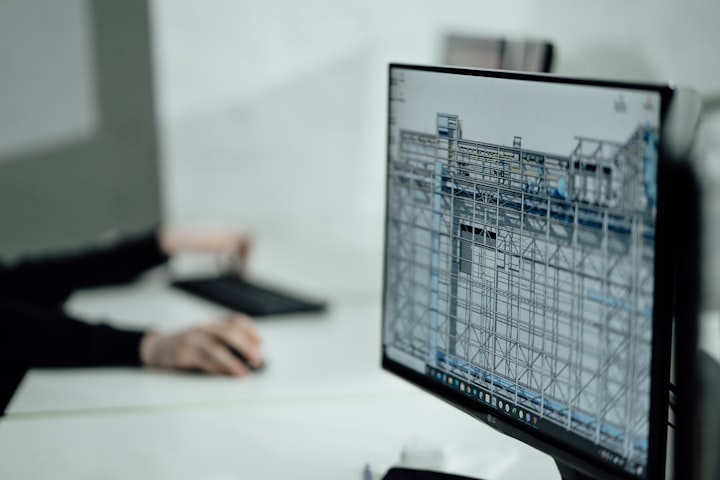Architectural Design
Design in architecture is a critical aspect that has the potential to make or break the overall success of a building project. Architecture, at its core, is a creative field, and good design is what separates a mediocre building from a great one. The role of design in architecture is not just limited to creating beautiful buildings; it also encompasses functionality, sustainability, and meeting the needs of the client and users.

Design in architecture is a critical aspect that has the potential to make or break the overall success of a building project. Architecture, at its core, is a creative field, and good design is what separates a mediocre building from a great one. The role of design in architecture is not just limited to creating beautiful buildings; it also encompasses functionality, sustainability, and meeting the needs of the client and users.
Sustainability and green design have become increasingly important in architecture. Architects are designing buildings with a focus on reducing the environmental impact and creating more sustainable communities. This includes using environmentally friendly materials, incorporating energy-efficient systems, and designing buildings to maximize natural light and ventilation.
Accessibility and universal design are also crucial components of design in architecture. Architects must design buildings and spaces that are accessible to all, regardless of their physical abilities. This includes considerations such as wheelchair accessibility, easy-to-navigate spaces, and other features that ensure that everyone can enjoy the building equally.
Technology and innovation have also transformed the way architects approach design. Architects can now use advanced software to create 3D models of buildings, which allows them to experiment with new materials and construction techniques. This technology enables architects to test designs and make changes before construction, reducing errors and saving time and resources.
Urban planning and design are also essential topics in architecture. Architects must work with urban planners to design buildings that fit within the context of a city or community. This involves considering factors such as traffic patterns, public transportation, and the needs of local businesses and residents.
Finally, historic preservation is an important topic in architecture. Architects must find ways to preserve historic buildings and landmarks while incorporating modern amenities and design features. This requires a delicate balance between preserving history and creating functional and livable spaces.
In conclusion, design in architecture is a multifaceted field that encompasses everything from sustainability to historic preservation. Good design is essential to creating buildings that are not only aesthetically pleasing but also functional, sustainable, and accessible to all. With advances in technology and a growing focus on sustainability, the role of design in architecture will continue to evolve and shape the future of building design.
Sustainability and Green Design

Sustainability and green design have become increasingly important in architecture. As our world faces growing concerns over climate change, architects are seeking new ways to design buildings that have a minimal impact on the environment. This includes using environmentally friendly materials, incorporating energy-efficient systems, and designing buildings to maximize natural light and ventilation.
One of the primary concerns in sustainable design is reducing a building's energy consumption. This is achieved through the use of passive solar design, which involves designing buildings that naturally collect and store heat from the sun. Architects can also incorporate energy-efficient systems such as solar panels, geothermal heating and cooling, and rainwater harvesting systems.
Another important aspect of sustainability in architecture is using environmentally friendly materials. This includes using materials that are sustainably sourced and have a minimal environmental impact. For example, architects may use wood that is harvested from certified sustainable forests or choose materials that have a low carbon footprint.
Designing buildings to maximize natural light and ventilation is another key component of green design. By using large windows and skylights, architects can allow natural light into a building, reducing the need for artificial lighting. Architects can also design buildings to maximize natural ventilation, which can help reduce the need for air conditioning.
Finally, sustainability in architecture also involves designing buildings that are adaptable and flexible. Buildings that can be easily adapted to new uses can help reduce waste and prolong their lifespan. This involves designing buildings with flexible floor plans, adaptable building systems, and using durable and low-maintenance materials.
In conclusion, sustainability and green design are essential components of design in architecture. Architects have a responsibility to design buildings that have a minimal impact on the environment and promote sustainable living. By incorporating energy-efficient systems, using environmentally friendly materials, and designing buildings to maximize natural light and ventilation, architects can create buildings that are not only beautiful but also sustainable and functional for years to come.
Accessibility and Universal Design

Accessibility and universal design are crucial components of design in architecture. Architects must design buildings and spaces that are accessible to all, regardless of their physical abilities. This includes considerations such as wheelchair accessibility, easy-to-navigate spaces, and other features that ensure that everyone can enjoy the building equally.
One of the primary concerns in accessibility design is ensuring that buildings are wheelchair accessible. This includes designing entrances that are wide enough for wheelchairs, using ramps or elevators to access different levels, and designing restrooms that are accessible to people with disabilities.
Easy-to-navigate spaces are also important in accessibility design. Architects must design buildings that are easy to navigate, with clear signage and pathways that are free of obstacles. This is particularly important in public buildings such as schools, hospitals, and government offices.
Universal design is a related concept that goes beyond accessibility. Universal design involves designing buildings and spaces that can be used by everyone, regardless of their physical abilities. This includes designing buildings with features such as non-slip flooring, wide doorways, and lever-style door handles that can be easily operated by people with limited hand strength.
Incorporating universal design principles into architecture can also benefit people who are not typically considered to have disabilities. For example, using natural light and avoiding glare can benefit people with visual impairments, but it can also benefit everyone who uses the space.
In conclusion, accessibility and universal design are critical components of design in architecture. Architects must design buildings and spaces that are accessible to all, regardless of their physical abilities. By incorporating features such as wheelchair accessibility, easy-to-navigate spaces, and universal design principles, architects can create buildings that are not only functional but also welcoming and inclusive for everyone.
Technology and Innovation

Technology and innovation have transformed the way architects approach design in architecture. Architects can now use advanced software to create 3D models of buildings, which allows them to experiment with new materials and construction techniques. This technology enables architects to test designs and make changes before construction, reducing errors and saving time and resources.
One of the primary benefits of technology in architecture is the ability to create detailed and accurate models of buildings. 3D modeling software allows architects to create realistic visualizations of their designs, which can be used to communicate their ideas to clients, contractors, and other stakeholders. This technology also allows architects to experiment with different materials, colors, and textures, giving them greater flexibility and creativity in their designs.
Another benefit of technology in architecture is the ability to improve building performance. Architects can use energy modeling software to predict a building's energy consumption, allowing them to design buildings that are more energy-efficient. This technology can also be used to optimize a building's orientation, design features such as windows and insulation, and even the placement of electrical outlets and light switches.
Building information modeling (BIM) is another important technology in architecture. BIM software allows architects to create detailed digital models of buildings that include information about every aspect of the design, from the materials used to the dimensions of each room. This technology can help architects and contractors collaborate more effectively, reducing errors and improving the overall quality of the building.
Finally, virtual reality (VR) and augmented reality (AR) are emerging technologies that are transforming the way architects design buildings. With VR and AR technology, architects can create immersive virtual environments that allow clients and stakeholders to experience a building before it is built. This technology can also be used to simulate different lighting conditions and even simulate how a building will perform in different weather conditions.
In conclusion, technology and innovation have transformed the way architects approach design in architecture. By using 3D modeling software, energy modeling software, BIM, VR, and AR technology, architects can create more accurate, sustainable, and innovative designs. As technology continues to evolve, the role of technology in architecture will only become more important in shaping the future of building design.
Urban Planning and Design

Urban planning and design are essential components of design in architecture. Urban planners and architects work together to create buildings and spaces that are not only functional and aesthetically pleasing but also meet the needs of the community they serve.
Urban planning is the process of designing and managing the physical, social, and economic aspects of cities and towns. It involves developing comprehensive plans for the use of land and resources, as well as determining how buildings and infrastructure will be designed and constructed. Urban planning also considers issues such as transportation, public spaces, and environmental sustainability.
Architects play a critical role in urban planning by designing buildings and public spaces that contribute to the overall character and functionality of the community. They work closely with urban planners to ensure that buildings and spaces are designed to meet the needs of the community and promote sustainable development.
One of the primary goals of urban planning and design is to create walkable communities. This involves designing streets and public spaces that are pedestrian-friendly and encourage people to walk and cycle rather than drive. Walkable communities also promote social interaction and reduce the environmental impact of transportation.
Another important goal of urban planning and design is to create mixed-use developments. This involves combining residential, commercial, and industrial uses in the same area, creating a more diverse and vibrant community. Mixed-use developments also promote a more sustainable use of resources, reducing the need for people to travel long distances for work or shopping.
Finally, urban planning and design must also address environmental sustainability. This involves designing buildings and spaces that are energy-efficient, use sustainable materials, and minimize the impact on the natural environment. Green roofs, rainwater harvesting, and solar panels are just a few examples of the sustainable design features that architects can incorporate into their designs.
In conclusion, urban planning and design are critical components of design in architecture. By working together to create walkable communities, mixed-use developments, and sustainable buildings and spaces, architects and urban planners can create vibrant, livable communities that meet the needs of everyone who lives, works, and plays there.
Historic Preservation

Historic preservation is an important aspect of design in architecture. It involves the conservation and restoration of historic buildings and landmarks, ensuring that they are preserved for future generations to enjoy. Historic preservation is important not only for preserving cultural heritage but also for creating vibrant, livable communities.
One of the primary goals of historic preservation is to maintain the historical integrity of a building or landmark. This involves preserving its original design, materials, and character as much as possible. Historic preservationists work to restore buildings to their original condition, using traditional materials and techniques to ensure that the building's historical significance is preserved.
Another goal of historic preservation is to adapt historic buildings for modern use. This involves making changes to the building's design and layout to make it more functional while still preserving its historical integrity. This can involve adding modern amenities, such as elevators and air conditioning, while preserving the building's original features.
Historic preservation is also important for creating a sense of place and identity in communities. Historic buildings and landmarks are often the centerpieces of a community's cultural heritage, providing a link to the past and helping to define the community's character. Preserving these buildings and landmarks helps to create a sense of continuity and community identity, which can help to foster a sense of pride and ownership among community members.
Finally, historic preservation is important for promoting sustainable development. By preserving historic buildings, communities can reduce the environmental impact of new construction and development. Preserving historic buildings also helps to promote the use of traditional building techniques and materials, which are often more sustainable and environmentally friendly than modern building materials.
In conclusion, historic preservation is an important aspect of design in architecture. By preserving the historical integrity of buildings and landmarks, adapting them for modern use, and promoting a sense of place and community identity, architects and historic preservationists can create vibrant, livable communities that are both culturally rich and environmentally sustainable.
About the Creator
Furkan Ceylan
Freelancer Architect, Interior Designer, NFT producer, Speaker, Content Writer
Reader insights
Outstanding
Excellent work. Looking forward to reading more!
Top insights
Compelling and original writing
Creative use of language & vocab
Expert insights and opinions
Arguments were carefully researched and presented
Masterful proofreading
Zero grammar & spelling mistakes
Easy to read and follow
Well-structured & engaging content
Eye opening
Niche topic & fresh perspectives
Heartfelt and relatable
The story invoked strong personal emotions






Comments (3)
Thank you!
Nice!
Amazing!